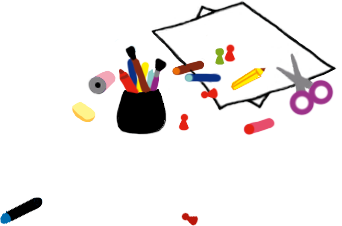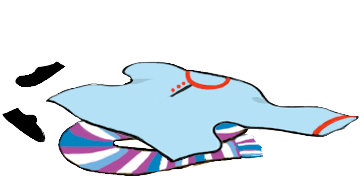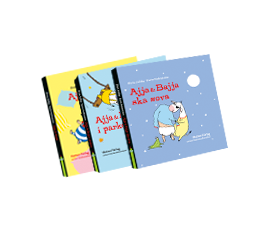Tutorial: How to get the most out of Pippa & Boo
Pippa & Boo have been specially designed to support children’s early language development in a fun and engaging way! Start off with reading one of the books together with your child, so that he or she gets to know the characters, then you can move on to playing with the dolls and the theatre set or playing the lotto game.
Don’t forget to ask your child what she or he would like to do next, and keep in mind that they might answer with a look, a gesture, a sign, a sound or a word. If you have trouble in understanding each other then you can show your child everything that’s available and let her or him point to or reach for whatever he or she wants. Name the child’s choice by saying the word out loud, so that the child has a model for how he or she can say it in the future.
When you read …
… take the opportunity to use sounds, gestures and signs! Before children learn to speak they express themselves with body language and gestures, and if we adults use signs when we talk to them then we are models for how they can communicate in turn.
Read and have a nice, cosy time with your child, making the signs at the same time you are reading the words aloud. Then, try and use the signs in everyday life too – for example, when you’re going to the playground or it’s time for bed. If the child has started to talk a little bit, one can primarily concentrate on the signs for those words that the child can’t yet say, to build vocabulary; but sign and use gestures as much as possible, it’s a great way to boost language development! It doesn’t matter if you sometimes get it wrong, the important thing is for you and your child to find a way to communicate and to understand each other.

You can learn the signs by looking at the Sign Glossary at the back of each book, but there are also a number of apps and websites you can use to find tutorial videos that show you how to make the signs. The Pippa & Boo books are available with signs from both American Sign Language and British Sign Language.
The Pippa & Boo stories are written in such a way that they quickly grab the child’s attention and encourage them to say the words and make the signs. The fact that all three characters often do the same thing means that you can be a model for the child and say, for example, “Pippa has a bath,” and then start the next sentence, “Boo has a …” and see if the child can complete the sentence with a sign or words. Eventually, the child might say the whole sentence him or herself. If the child doesn’t want to, or can’t, say or sign anything, then just carry on reading “Boo … has a bath”, and try again another day.
Have fun too playing with all the onomatopoeic words like SPLASH and BANG that appear in the text. They tend to be easier for children to learn than ordinary words, and of course children can use them to show what they want or what they are thinking about. SPLASH could mean they want to play with water or have a bath, for example. Don’t ever feel that you have to stick exactly to what the text says. Feel free to find other sounds, look at the pictures to find other exciting things that you can put into words, and when the child has started to speak/sign more then perhaps you’ll want to read “Pippa climbs up onto the sofa.” Rather than just “Pippa climbs up.”A major benefit of using sounds, signs and gestures like this is that the children, at an early stage, interact and communicate more with others, and that in itself stimulates language development. And above all, it is exciting for us adults to find out more about what our little ones are thinking!
When you play …
… with the dolls and theatre, it can of course be based on what happens in the books, but don’t be limited by that! Feel free to add in your own toys, so if the child likes dinosaurs maybe Pippa & Boo can play with dinosaurs too, or even be chased by a Tyrannosaurus Rex?
 Let the child be involved and decide things as much as possible, as playing automatically stimulates communication and language development. If necessary, you can make suggestions: “Should Pippa have a bath? Or jump on the sofa?”, and see if the child can respond with gestures, signs or words.When you and your child are playing, put words to everything you are doing.
Let the child be involved and decide things as much as possible, as playing automatically stimulates communication and language development. If necessary, you can make suggestions: “Should Pippa have a bath? Or jump on the sofa?”, and see if the child can respond with gestures, signs or words.When you and your child are playing, put words to everything you are doing.
If you try to be just one step ahead of the child in what you say you’ll be an excellent model for how the child can develop his or her own speech. If your child starts to sign single words, you can sign and say two-word phrases. If the child says short sentences like “Pippa bath”, you can say even longer ones, “Yes, Pippa is having a bath.” But obviously you can use much longer sentences too, as they help to build language comprehension.
Take the opportunity too to use all the onomatopoeic words from the books. It’s fun to say words like “BOINK!”, “BANG!” and “CRASH!”
Later on, while you are playing you can practice a variety of linguistic skills, such as:
• Forming two and three-word phrases. Tailor the questions you ask so that you encourage the child to say whole sentences. “Should Pippa go down the slide? Or should Boo go down the slide?” Then slowly and clearly put into words what it is the dolls do (perhaps together with the child). “Boo is going down the slide.”
• Vocabulary building. Use and name all of the accessories that come with Pippa & Boo’s theatre, and then add more things as you play. Maybe Pippa could lock the door with a key when they go out, and put the key in a bag, and so on.
• Following instructions and understanding language. Give the child information and then follow up with instructions. For example, “Pippa is hungry. Give her a sandwich!” Or maybe Pippa could say” I want to swing, and then go down the slide!” and then the child can help her do these things. Tailor the instructions to what the child can deal with and help if necessary.
• Using prepositions and tricky concepts. For example, have Pippa hide and have Boo look for her – “Pippa is under the table” and “Pippa is behind the biggest chair.”
Only our imagination sets the limits!
And finally…
… you don’t need to sit around a table to help children develop language. Pippa & Boo’s rhymes have been written to fit the daily routines of life. Saying the “Getting Dressed” rhyme while putting clothes on can make getting dressed both fun and an opportunity for language development.
Another great strategy is to follow the children’s interest in everyday life and to name and talk about whatever it is that they are looking at, for example, when walking home from preschool or standing in the queue at the supermarket.It is also good to speak slowly and clearly, and to use simple sentences. It becomes easier for the children to understand, but it also means that you become a better model for the children to copy.
But make sure to pause often too, so that your child gets time to contribute his or her own thoughts. Listen and really pay attention: they can answer in all sorts of ways, including gesturing and copying you. And don’t be afraid to over-interpret a little. If you think that hand waving in the air looks like “come here” then react as if it did! If that “ite” might be “light”, then say “Yes, light. Did you say light?” Even if the child did not say what you thought, they learn that if they say/do things, you answer them. Of course, it is important to make sure that the child doesn’t become upset or annoyed if misunderstandings arise, if they do then you can back up a little and try again: “No, it wasn’t light. What was it you were thinking of?”
You can’t force children into speech or communication, but you can arrange situations where it will be tempting for the child to speak. For example, put some toy cars and Pippa just out of reach and ask with both words and signs “Should we play with Pippa or the cars?”
Remember that any way of answering is good, be it with a word or a sign or a gesture! When children don’t get something entirely right it isn’t necessary to correct them, but a good habit to get into is to always repeat back what they have said, but correctly (and maybe a little longer). If the child says “Pippa, wheee” you can say “Yes, Pippa swings. Wheee “and if the child says “Boo bath” you can say “Yes, Boo is having a bath, in the bathtub.”
And finally, language develops in interaction with others, and some children develop quickly and others need more time. Be sure to spend a little time each day in language-boosting activities! Do fun things together, play, talk and read books!





